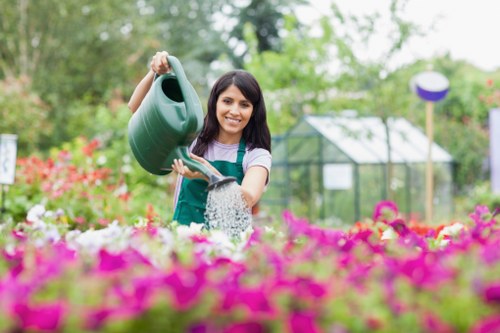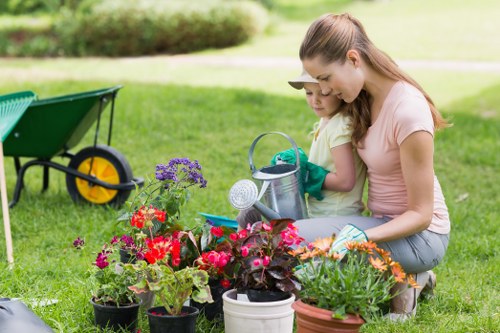Mastering Garden Fence Installation for Landscape Gardeners

Understanding the Importance of Garden Fencing
Installing a garden fence is a pivotal element in landscape gardening. It not only defines the boundaries of your garden space but also adds aesthetic value, enhances privacy, and ensures security.
Choosing the right fence can transform your garden into a more organized and appealing space. Whether you're aiming for a rustic charm or a modern look, the type of fence you select plays a crucial role in achieving your desired outcome.
Moreover, a well-installed fence can protect your garden from unwanted intrusions, safeguard pets, and keep wildlife in check, creating a harmonious environment for both plants and inhabitants.

Choosing the Right Materials for Your Garden Fence
Wooden Fences
Wooden fences are a popular choice among landscape gardeners due to their natural appearance and versatility. They can be customized with various stains and paints to match your garden's theme.
Pros and Cons of Wooden Fences
- Pros: Aesthetic appeal, customizable, provides good privacy.
- Cons: Requires regular maintenance, susceptible to weather damage.
Regular upkeep, such as painting or staining, is essential to prolong the life of wooden fences and maintain their appearance.

Metal Fences: Durability Meets Style
Wrought Iron and Aluminum Options
Metal fences, including wrought iron and aluminum, offer a sturdy and long-lasting solution for garden fencing. They are resistant to pests and weather, making them a low-maintenance option.
Benefits of Metal Fences
- Durability: Long-lasting and resistant to damage.
- Low Maintenance: Requires minimal upkeep compared to wood.
Metal fences can also be designed with intricate patterns, adding a decorative touch to your landscape.

Vinyl Fences: Modern and Versatile
Advantages of Vinyl Fencing
Vinyl fences are gaining popularity for their modern look and ease of maintenance. They come in various styles and colors, allowing for customization without the need for painting.
Why Choose Vinyl?
- Maintenance-Free: Does not require painting or staining.
- Weather Resistant: Can withstand harsh weather conditions without deteriorating.
Vinyl fences are also eco-friendly, as they can be recycled and do not emit harmful chemicals.

Installation Process: Step-by-Step Guide
Planning and Preparation
Before starting the installation, it's essential to plan the layout of your fence. Measure the area accurately, mark the fence line, and ensure you have all the necessary materials and tools.
Materials Needed
- Fencing panels or materials
- Posts and supports
- Concrete for setting posts
- Tools: Post hole digger, level, measuring tape
Proper preparation ensures a smooth installation process and a durable fence structure.
Post Installation: Securing Your Fence
Once the posts are set, attaching the fence panels securely is crucial. Ensure that each panel is level and evenly spaced to maintain a uniform appearance.
Using high-quality fasteners and hardware will enhance the stability and longevity of your garden fence.
Regular inspections after installation can help identify and address any issues promptly, ensuring your fence remains in optimal condition.
Maintenance Tips for Longevity
Maintaining your garden fence involves regular cleaning and inspections. For wooden fences, apply protective coatings to prevent moisture damage and decay.
Metal fences should be checked for rust and corrosion, addressing any signs of wear immediately to prevent further deterioration.
Vinyl fences require minimal maintenance, but occasional cleaning with mild detergents can keep them looking new.
Enhancing Aesthetics with Decorative Elements
Add decorative elements such as lattice panels, trellises, or finials to your fence design. These features can enhance the visual appeal and complement your garden's overall theme.
- Lattice Panels: Provide partial privacy while allowing light to filter through.
- Trellises: Perfect for supporting climbing plants and adding vertical interest.
Incorporating flowers or climbing vines can further beautify your fence, making it a focal point of your landscape.
Cost Considerations and Budgeting
Budgeting for a garden fence involves considering the cost of materials, labor, and any additional features. Wooden fences may have a lower initial cost but require ongoing maintenance expenses.
Metal and vinyl fences typically have higher upfront costs but offer better durability and lower maintenance in the long run.
- Wood: $10-$30 per linear foot.
- Metal: $20-$40 per linear foot.
- Vinyl: $15-$35 per linear foot.
Assess your budget and long-term maintenance capabilities to choose the most suitable fencing option for your garden.
Permits and Regulations
Before installing a garden fence, check with local authorities regarding permits and zoning regulations. Some areas have restrictions on fence height, materials, and placement.
Obtaining the necessary permits ensures compliance with local laws and prevents potential fines or removal of the fence.
Common Regulations
- Maximum fence height restrictions.
- Setback requirements from property lines.
- Prohibited materials or styles.
Consulting with local building departments can provide clarity on the regulations applicable to your area.
Hiring a Professional vs. DIY Installation
Deciding between hiring a professional landscaper or undertaking a DIY fence installation depends on your skill level, budget, and project complexity.
- Professional Installation: Ensures quality workmanship, saves time, and adheres to local regulations.
- DIY Installation: Cost-effective and allows for personal customization but requires time and effort.
Assess your capabilities and resources to make an informed decision that aligns with your garden's needs.
Eco-Friendly Fencing Options
Eco-conscious gardeners might prefer sustainable fencing materials. Options like recycled metal, bamboo, or sustainably sourced wood contribute to an environmentally friendly landscape.
Choosing eco-friendly materials reduces your garden's carbon footprint and supports sustainable practices.
Benefits of Sustainable Fencing
- Reduced Environmental Impact: Utilizes renewable or recycled resources.
- Durability: Often longer-lasting, reducing the need for frequent replacements.
Integrating sustainable fencing options aligns with eco-friendly gardening principles and promotes a healthier planet.
Integrating Fences with Garden Design
A fence should complement your garden's design rather than detract from it. Consider the style, color, and material of your fence to ensure it harmonizes with other garden elements.
For example, a wrought iron fence pairs well with formal gardens, while a wooden picket fence suits cottage-style landscapes.
- Color Coordination: Match fence colors with existing structures or plantings.
- Style Consistency: Maintain a uniform style for a cohesive look.
Thoughtful integration enhances the overall aesthetic appeal and functionality of your garden space.
Common Challenges and Solutions
Installing a garden fence can present challenges such as uneven terrain, debris in the soil, or encountering utility lines. Proper planning and preparation can mitigate these issues.
Dealing with Uneven Ground
- Solution: Use adjustable posts or level the ground before installation.
Addressing ground irregularities ensures a straight and stable fence line.
Managing Utilities
- Solution: Contact utility companies to identify and mark underground lines before digging.
Preventing accidental damage to utilities is essential for safety and compliance.
Enhancing Security with Fencing
A sturdy fence adds an extra layer of security to your garden, deterring trespassers and protecting valuable plants and assets.
Incorporate features like locks, sturdy gates, and higher panels to enhance the security benefits of your garden fence.
- Locks: Secure gates to prevent unauthorized access.
- Sturdy Materials: Use durable materials that resist tampering and break-ins.
Secure fencing contributes to peace of mind, allowing you to enjoy your garden without concerns.
Seasonal Maintenance Tips
Different seasons require specific maintenance practices to keep your garden fence in top condition. For instance, spring is ideal for inspecting and repairing any winter damage.
Spring Care
- Inspect for damage caused by storms or freezing temperatures.
- Clean and apply protective coatings to wooden fences.
Summer maintenance focuses on cleaning and addressing any wear from high temperatures and sunlight exposure.
Conclusion: Elevate Your Garden with the Perfect Fence
Installing a garden fence is a significant step in enhancing the functionality and beauty of your landscape. By carefully selecting materials, planning the installation, and maintaining your fence, you can create a lasting and appealing garden space.
Whether you choose a traditional wooden fence, a modern metal design, or an eco-friendly option, the right fence can transform your garden into a sanctuary that reflects your personal style and meets your practical needs.
Contact us today to start your garden fence installation and take the first step towards a more beautiful and secure landscape.